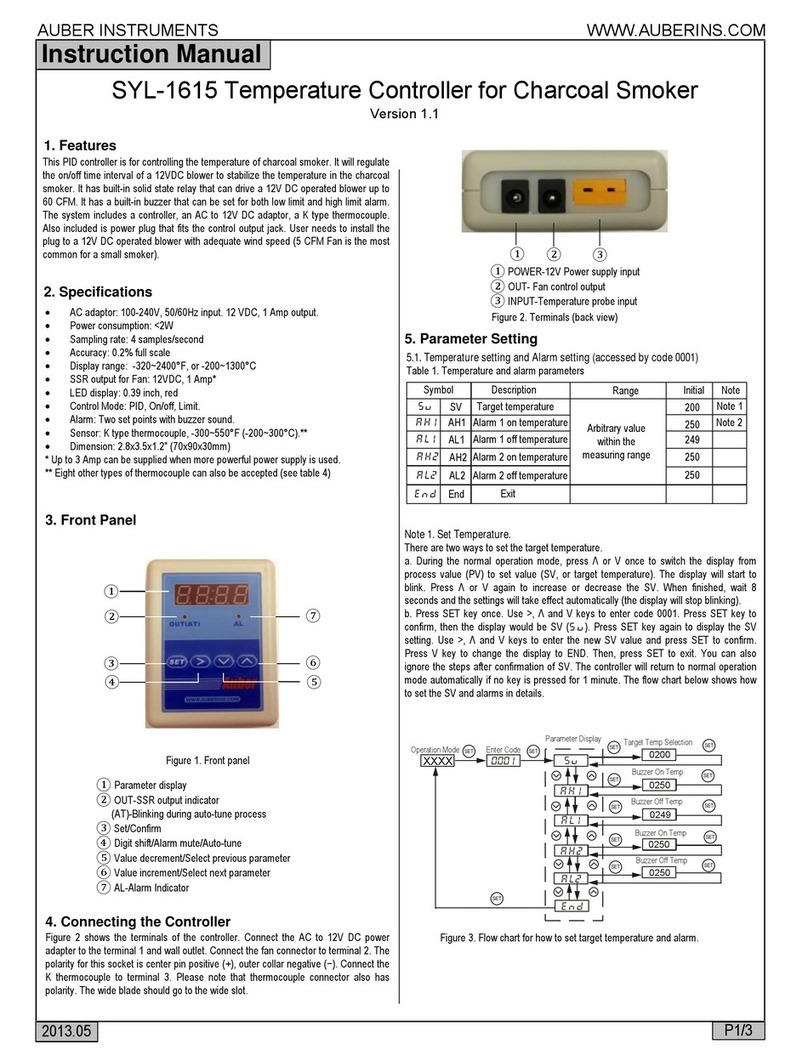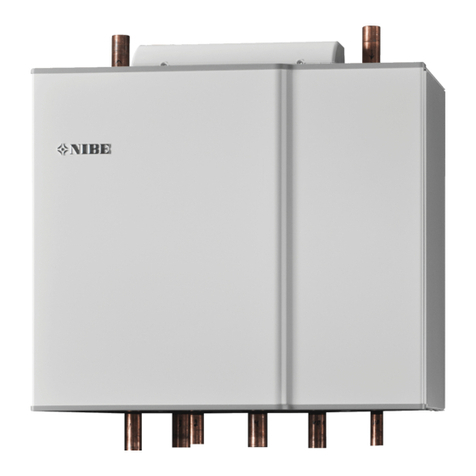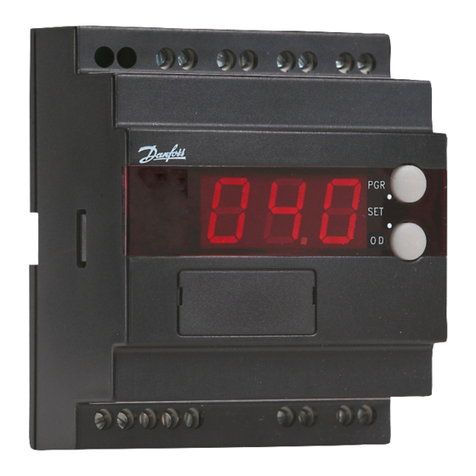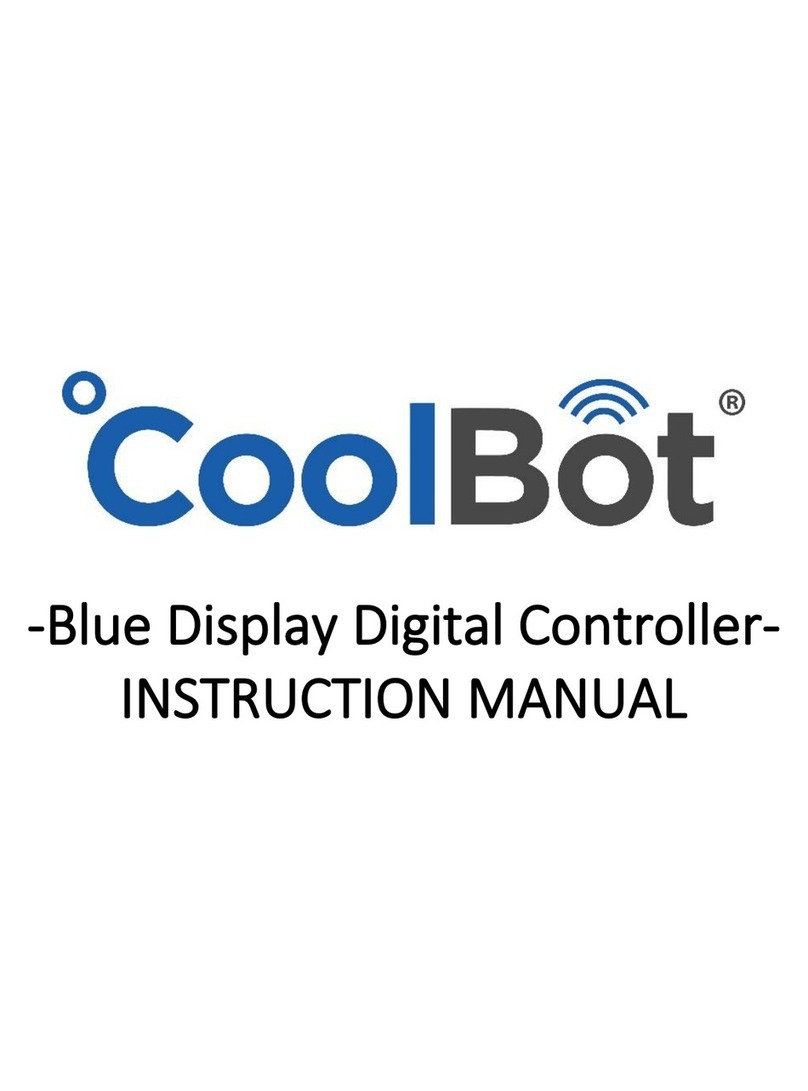Hanyoung HX4 User manual

-1-
MA0614E170926
※ HX9 is
chosen to explain
①
②
⑦
⑥ ⑤ ④ ③
█
External Contact Input (DI) Selection
3 predetermined set values (temperature values) could be changed with using
ON/OFF of the external 2 contact inputs
Model Code Description
HX ☐ - ☐ ☐ Multi-input and output digital temperature controller
Dimension
2 48(W) × 96(H) ㎜
PID Auto-tuning
3 96(W) × 48(H) ㎜
4 48(W) × 48(H) ㎜
7 72(W) × 72(H) ㎜
9 96(W) × 96(H) ㎜
Control output
0 Standard
1 Heating / Cooling (simultaneous control)
HX2/3/9 option 0 None
1 RS485 communication + Heater break alarm (HBA)
HX7 option
0 None
1 RS485 communication + DI 2 contacts (SV2, SV3)
2 RS485 communication + Heater break alarm (HBA)
HX4 option
0 None
1 RS485 communication + DI 1 contact (SV2)
2 RS485 communication + Heater break alarm (HBA)
1381-3, Juan-Dong, Nam-Gu Incheon, Korea,
TEL:(82-32)876-4697 FAX:(82-32)876-4696 http://www.hynux.com
HANYOUNGNUX CO.,LTD
HEAD OFFICE
Suffix code
Part name and function
Safety information
Alerts declared in the manual are classified to Danger, Warning and Caution by their criticality.
•Please install an appropriate protective circuit on the outside. Malfunction or an incorrect operation may be
a cause of leading to a serious accident.
•
Since this product does not have the power switch or a fuse, please install those separately on the outside. (Fuse rating : 250 V 0.5 A)
•To prevent damage or failure of this product, please supply the rated power voltage.
•To prevent electric shock or equipment failure, please do not turn on the power until completing wiring.
•
Since this is not explosion-proof structure, please do not use in a place where combustible or explosive gas is around.
•Never disassemble, modify or repair the product. There is a possibility of malfunction, electric shock or a risk of fire.
•Please turn off the power when mounting/dismounting of the product.This is a cause of electric shock, malfunction, or failure.
•
If the product is used with methods other than specified by the manufacturer, it may lead to injury or property damage.
•
Since there is a possibility of electric shock, please use the product as mounted on a panel while the power is being supplied.
•If it is used with systems, machines and equipment that could lead to a risk of life or property damage, please
implement safety devices and protections for both lives and the applications and plan for preventing accidents.
Warning
Do not touch or connect any undesirable conductive part to input-output terminal,
since there is a possibility of electric shock.
Danger
•The contents of the instruction manual are subjective to change without prior notice.
•Please make sure that the specification is the same as exactly you have ordered.
•Please make sure that the product is not damaged during shipping.
•
Please use this product in a place where the ambient operating temperature is 0 ~ 50 ℃ (40 ℃ max, closely installed)
and the ambient operating humidity is 35 ~ 85 % R.H (without condensation).
•Please use this product in a place where corrosive gas (such as harmful gas, ammonia, etc.)
and flammable gas do not exist.
•
Please use this product in a place where there is no direct vibration and a large physical impact to the product.
•Please use this product in a place where there is no water, oil, chemicals, steam, dust, salt, iron or
hazardous substances (Contamination class 1 or 2).
•Please do not wipe this product with organic solvents such as alcohol,
benzene or others. (Please use mild detergent instead)
•
Please avoid places where excessive amount of inductive interference and electrostatic or magnetic noise occurs.
•Please avoid places where heat accumulation occurs due to direct sunlight or radiant heat.
•Please use this product in a place where the elevation is below 2,000 m.
•
Please make sure to inspect the product if exposed to water, since there is a possibility of electric leakage or a risk of fire.
•
For thermocouple (TC) input, please use a prescribed compensation lead wire. (There will be a temperature error if a general lead is used.)
•
For resistance temperature detector (RTD) input, please use a small resistance of lead wire and the 3 lead wires should
have the same resistance. (There will be a temperature error if the 3 lead wires do not have the same resistance.)
•
Please keep the input signal wire away from the power lines and load lines to avoid the effect of inductive noise.
•The input signal wires and output signal wires should be separated from each other.
If it is not possible, please use shielded wires for the input signal wires.
•For thermocouple (TC), please use ungrounded sensors. (There is a possibility of
malfunction of the product by electric leakage, if a grounded sensor is used.)
•If there is a lot of noise from the power line, installing an insulated transformer or a noise filter
is recommended. The noise filter should be grounded on the panel and the wire between
the output of the noise filter and the power of the instrument should be as short as possible.
•It is effective against noise, if the power lines of the product are made twisted pair wiring.
•Please make sure the operation of the product before using, since the product may not
operate as it intends to if the alarm function is not properly set.
•While replacing the sensor, please turn off the power.
•In case of the high frequent operation, such as proportional operation, please use an auxiliary
relay since the life span of the output relay will be shortened if it connects to the load without
the rated margin. In this case, SSR output is recommended.
*For Electromagnetic switch : set cycle time : minimum 20 sec.
*For SSR : set cycle time : minimum 1 sec.
•Please do not connect anything to the unused terminals.
•Please connect wires properly after making sure the polarity of the terminals.
•Please use a switch or breaker (IEC60947-1 or IEC60947-3 approved)
when the product is mounted on a panel.
•Please install a switch or break near the operator to facilitate its operation.
•
If a switch or breaker is installed, please put a name plate that the power is off when the switch or breaker is activated.
•In order to use this product properly and safely, we recommend periodic maintenance.
•Some parts of this product have limited expected life span and aged deterioration.
•The warranty of this product (including accessories) is
1 year only when it is used for the purpose it was intended to under normal condition.
•When the power is being supplied there should be a preparation time for the contact output. Please
use a delay relay together when it is used as a signal on the outside of interlock circuit or others.
•When the user replaces with a spare unit due to product failure or other reason,
please check the compatibility since the operation can be varied by
the difference of setting parameters even though the model name and code are the same.
•Before using a temperature controller, there could be a temperature difference between
PV of the temperature controller and the actual temperature, so please operate the temperature
controller after correcting the temperature difference appropriately.
CAUTION
DANGER indicates an imminently hazardous situation which,
if not avoided, will result in death or serious injury.
WARNING indicates a potentially hazardous situation which,
if not avoided, could result in death or serious injury.
CAUTION indicates a potentially hazardous situation which,
if not avoided, may result in minor or moderate injury.
DANGER
WARNING
CAUTION
Number
Name Description
①Process value (PV) Displays the process value in the operation mode.
②Set value (SV) Displays the set value in the operation mode.
③Up key Increases the set value or used to move between groups and
to change an option in a parameter in setting mode.
④Down
key
Decreases the set value or used to move between groups and
to change an option in a parameter in setting mode.
⑤Shift key Used to move the position of the digit.
⑥Set key
Sets (confirm) the set value, displays the output amount, or set an
option in a parameter in setting mode and moves between the
parameters in a group. By pressing for 3 seconds, it enters the
display setting mode (setting mode) or returns to the operation mode.
⑦Operation
Indicator
Lights when SV2 is displayed.
Lights when SV3 is displayed.
OUT1 indicator.
OUT2 indicator.
Auto-tuning indicator (blink).
Alarm 1 operation indicator.
Alarm 2 operation indicator.
⑧
+
Hot
key(run/
stop)
Hot key is designated for AT or Manual MV
configuable in the group of "G.CtL"
⑨
+
Quick
menu
Sets the value: SV1, SV2, AL1, AL2
External input
contact
selection
( )
OFF (contact input is not used)
ON (contact input is used)
No display
External contact input SV2 SV3
Set value 1 display (SV1)
OFF OFF
Set value 2 display (SV2)
ON OFF
Set value 3 display (SV3)
OFF ON
Thank you for purchasing HANYOUNG product.
Please check whether the product is exactly the same as you ordered.
Before using the product, please read this instruction manual carefully.
Please keep this manual where you can view at any time.
INSTRUCTION MANUAL
HX series
Digital Temperature Controller

-2-
Input code for input type and range
Setting Mode
56 78
9
®34
DISP 1
DISP 2
DISP 3
1 2 3
Power On
1) Operation
mode
Process value
Set value
Process value
Output amount
PV
SV
PV
SV
Control group
Auto-tuning group
Setting value group
PID group
Alarm group
RET. group
COM. group
Output group
Input group
HBA group
for 3 seconds
for 3 seconds
for 3 seconds
for 3 seconds
for
3 seconds
HOTKEY
+
Level
+
Quick menu
+
Ramp
function
type A
Ramp
function
type B
※ In the standard type, Retransmission output (RET) is only available from OUT2.
(1) Standard type
Type Output
code
OUT1(Heating) OUT2 Default
Relay SSR/SCR/RET Relay
SSR/SCR/RET
Standard
Type
0Control output
(ON/OFF) -
AL2
(Alarm 2
output)
RET
(retransmission
output)
1
1-SSR
2
SCR(4 - 20 mA)
3Control output
(PID) -
Input signal Input signal Input type Range (℃) Accuracy Note
Thermocouple
(TC)
1K *1 -200 ~ 1370
±0.5 % of FS ±1 Digit
•FS is the measurable range
from the maximum to the minimum
for each range.
• Digit is the minimum display value
❇1 below 0 ℃ :
±1.0 % of FS ± 1 digit
❇2 0 ~ 400℃ range :
±10 % of FS ± 1 digit
❇3 20 KPt100 Ω (C1603)
21, 22 Pt100 Ω(IEC751)
*4 In case of using Current input,
Resistor 250 Ω 0.1 % should be
installed in the input terminal.
2K *1 -199.9 ~ 999.9
3J *1 -100.0 ~ 999.9
4E *1 -100.0 ~ 999.9
5T *1 -199.9 ~ 400.0
6R 0 ~ 1700
7B *2 0 ~ 1800
8S 0 ~ 1700
9L *1 -100.0 ~ 900.0
10 N-200 ~ 1300 ±1.0 % of FS ±1 Digit
11 U *1 -199.9 ~ 400.0
±0.5 % of FS ±1 Digit12 W0 ~ 2300
13 Platinel II 0 ~ 1390
Resistance
temperature
detector
(RTD)
20 KPt100 Ω *3 -199.9 ~ 500.0
±0.5 % of FS ±1 Digit
21 Pt100 Ω *3 -199.9 ~ 640.0
22 Pt100 Ω *3 -200 ~ 640
DC voltage
(VDC / ㎷ DC)
30 1.000 - 5.000 V DC
-1999 ~ 9999
Scaling function(SL-H/SL-L) necessary ±0.5 % of FS ±1 Digit31 0.0 - 100.0 ㎷ DC
DC current 30 4 - 20 ㎃ DC *4
█ Control Output Composition
HX series is a multi-control-output temperature controller. It can have relay ON/OFF,
SSR voltage pulse output, 4 – 20 mA current output as a control output by selecting an option in the parameter.
If the option is chosen like below in the output parameter ( ) of the output group ( ) in standard temperature controller
0 : Relay ON/OFF control is as a control output.
1 : SSR output is as a control output.
2 : 4 – 20 mA DC current output is as a control output.
3 : Relay PID control is as a control output.
(2) Heating / Cooling Type ( simultaneous control)
Type Output
code
OUT1(Heating) OUT2 Default
Relay SSR/SCR/RET Relay(AL2) SSR/SCR/RET
Heating /
Cooling
type
4 - SSR
AL2
(Alarm 2
output )
SSR
4
5 - SCR(4 - 20 mA)
6
Control
output (PID)
RET
(retransmission
output)
7 - SSR
SCR
(4 - 20 mA)
8 - SCR(4 - 20 mA)
9
Control
output (PID)
RET
(retransmission
output)
10 -SSR
Control output
(PID)
RET
(
Retransmission
output
)
11 -SCR(4 - 20 mA)
12
Control
output (PID)
-

-3-
█ When turn the power ON after completing wiring
Operation Method
(1)
After the firmware version of the temperature controller appears for a short period of time, the operation
mode is running like the number ① that process value (current temperature)
and the set value are displayed.
(2) In the number ①, if button is pressed for 3 seconds, it enters
display setting mode.
It can be selected as DISP 1, DISP 2 and DISP 3 to limit displaying setting groups.
(3)
In the operation mode, if button is pressed, the output amount is displayed like the picture ⑤ - ⑥ below.
POWER ON
①
②
③④
Output amount
display
⑤Heating-
Cooling type
⑥ Standard type
for 3
seconds
for 3
seconds
for 3 seconds
●
Switching between modes
How to set access levels [Level (LEVL)] and a group display [Display (dISP)]
- Setting group configuration parameters are displayed according to the group display
[Display (dISP)] setting.
- Setting group is editable depending on setting Access Level [Level (LEVL)].
Access level [Level (LEVL)]
LEVL 3 :
parameter values can be changed for all setting groups with the key of controller in front.
LEVL 2 : parameter values can not be changed for output group and input group with
the key of controller in front.
LEVL 1 :
parameter values can not be changed for Auto-tuning group(G.At), PID
group(G.PId), Alarm Group (G.ALM), retransmission group(G.trn), communication
group(G.CoM), output group(G.oUt), input group (G.In) with the key of controller in front.
Caution
In the operation mode, if and button are pressed simultaneously for 3 seconds,
it enters setting mode which prevents an operator to change parameter setting as
limiting access to the group. The default is 3rd level. The level setting mode limits the
display setting mode.
Control group
Symbol Parameter Option
Available
condition
Default
Control group Options for control mode
-
-
Zone setting OFF / ON Control
output: PID OFF
Ramp function type A / B
Always on
A
Ramp rising temperature
OFF/ EUS (0 ~ 100%)
Ramp
function
type A
OFF
Ramp falling temperature
OFF/ EUS (0 ~ 100%) OFF
Ramp time unit HOUR / MIN HOUR
Ramp rising temperature
OFF/ EUS (0 ~ 100%)
Ramp
function
type B
OFF
Ramp rising time 0.01 ~ 99.59(hh.mm) 0.01
Ramp falling temperature
OFF/ EUS (0 ~ 100%) OFF
Ramp falling time 0.01 ~ 99.59(hh.mm) 0.01
External contact input
OFF / ON
Always on
OFF
Hot key setting AT / A-M AT
Auto/manual setting AUTO / MAN (1) AUTO
Control mode
TRAD / 2DOF
TRAD
2DOF
Alpha coefficient
0 ~ 100 %
Control
mode:
2DOF
50 %
Factory reset function 0/1 [PASSWORD: 1304] (2) Always on 0
Set value (SV) setting group
Auto-tuning (AT) group
Symbol Parameter Option
Available
condition
Default
P.I.D group
Symbol Parameter Option
Available
condition
Default
PID group Options for PID mode - -
ANTI RESET
WIND-UP setting Auto / 50.0 ~ 200.0 % PID
control 100 %
PID group setting 0 / 1 ~ 3 Always on 0
n. Proportional band (P)
0.1(H/C TYPE : 0.0) ~ 999.9 %
Selecting one
of PID groups
5.0 %
n. Integral time (I) OFF / 1 ~ 6000 s Always on 240 s
n. Derivative time (D) OFF / 1 ~ 6000 s Always on 60 s
n. Manual reset -5.0 ~ 105.0 %
Integral time:
OFF
50.0 %
n. Proportional band (PC)
for cooling
0.0(ON/OFF) / 0.1 ~ 999.9 %
heating·
cooling
5.0 %
n. Integral time (IC) for
cooling OFF / 1 ~ 6000 s 240 s
n. Derivative time (DC) for
cooling OFF / 1 ~ 6000 s 60 s
n. hysteresis (dead band) -100.0 ~ 50.0 % 3.0 %
n. Zone position setting EU(0) < 1.RP < 2.RP <
EU(100 %)
PID group 1
or
PID group 2
EU
(100 %)
Heater Break Alarm (HBA) group
Alarm group
Symbol Parameter Option
Available
condition
Default
Alarm group Options for alarm mode
-
-
Alarm 1 type setting OFF / 1 ~ 21
Refer to “Alarm type and code”
Always on
1
Alarm 2 type setting 2
Hysteresis (dead band)
of alarm 1
EUS(0 ~ 100 %) EUS
(0.5 %)
Hysteresis (dead band)
of alarm 2
Set value of alarm 1
Absolute alarm :
EU(-100 ~ 100 %)
Deviation alarm :
EUS(-100 ~ 100 %)
EU
(100 %)
Set value of alarm 2 EU
(0 %)
Retransmission (RET) group
Symbol Parameter Option
Available
condition
초기값
RET. Group Options for RET. Group.
- -
Retransmission type
or power for sensor
Process value(PV) / set value
(SV) / output amount (MV) /
power for sensor (SPS)
RET.
option PV
Retransmission value
4 - 20 mA / 0 – 20 mA (1) -
4-20mA
High limit of
retransmission
TC / RTD: FR-H ~ FR-L
DC voltage: SL-H ~ SL-L
( Must be RET.H > RET.L )
PV / SV
EU(100 %)
Low limit of
retransmission
EU(0 %)
(1)
If you want retransmission
0-5V
, a 250 Ω 0.1% resistor must be connected to retransmission output terminal.
If you want retransmission 0-10V, a 500 Ω 0.1% resistor must be connected to retransmission output terminal.
(1) When manual output function is selected with 'ON', 'AT indicator' lights on at the front panel.
(When auto-tuning (AT) is running, 'AT indicator' flashes at the front panel)
(2) when "1" is selected in factory reset function, PASSWORD is displayed. After input the
PASSWORD [1304], controller power turns off and on for initializing parameter values.
Auto-tuning group
Options for auto-tuning (AT) group
-
-
Auto-tuning type
setting
Standard (STD) :
Low PV (LOW) :
Control
output:
PID
STD
Auto-tuning start
setting
OFF / 1 ~ 3 / (AUTO)
OFF
Symbol Parameter Option
Available
condition
Default
Set value setting group Options for set values
-
-
Set value Number
setting
1~3 (the chosen set value is
displayed and controlled)
Always
on
1
Set value 1 (SV1) setting EU (0 ~ 100 %) EU(0 %)
Set value 2 (SV2) setting EU (0 ~ 100 %) EU(0 %)
Set value 3 (SV3) setting EU (0 ~ 100 %) EU(0 %)
Symbol Parameter Option
Available
condition
Default
Heater break alarm group
Options for HBA mode.
- -
Current setting of HBA output
OFF / 1 ~ 50 A HBA
Option
(Refer to
“model
name and
code”
table)
OFF
Hysteresis setting of HBA
output
0 ~ 50 EUS
(0.5 %)
Current measurement value of
HBA output
Only indicates current measurement
value (0 ~ 50 A)

-4-
Output group
Please make sure to choose “input code” in “input code setting” of the input
group first and then select “output code” in “output type setting” and other
options in other groups. If “input code” is set later, the options in the other
groups will be lost.
Caution
Symbol Parameter Option
Available
condition
Default
Output group Options for output type and
mode
-
-
Output type setting Refer to “control output
composition”
Always on
Std : 1
HC : 4
Output operation REV: reverse, DIR: direct Output code
0~3
REV
Cycle time 1 ~ 1000 s
relay : 20s
SSR : 2 s
Cycle time for cooling 1 ~ 1000 s Output code
4~12
Hysteresis
Standard : EUS(0 ~ 100 %)
ON/OFF
control
EUS(0.5 %)
Heating / Cooling:
0.0 ~ 10.0 %
Heating /
Cooling
0.5%
Hysteresis type Cntr / EdGE
ON/OFF
Control
Cntr
Output amount of
OUT1 when input break
Standard
: -5.0 ~ 105.0 %
Always on
0.0 %
Heating - Cooling : 0.0~105.0 %
Output amount of
OUT2 when input break 0.0 ~ 105.0 %
Heating /
Cooling
0.0 %
High limit of output
amount
Standard : OL-L + 1Digit~ 105.0 %
PID
control
100.0 %
Heating - Cooling : 0.0 ~ 105.0 %
Low limit of output
amount
Standard : -0.5 % ~ OL-H-1Digit
0.0 %
Heating - Cooling : 0.0 ~ 105.0 %
100.0 %
Input group
Symbol Parameter Option
Available
condition
Default
Input group
Options for input type and input
mode
-
-
Input code setting
Input signal and measurable
range code
Always on
Code : 1
Temperature unit setting
℃ / ℉
TC or RTD
℃
High limit setting
Within range (refer to “input
code for input type and
range”) , FR-H > FR-L
Always on
1370
Low limit setting
-200
Decimal point position
(voltage input)
Fixed for T.C or RTD / DC
voltage: 0~3 setting for
decimal point position
Voltage input
(mV,V)
1
High limit of scale (voltage
input)
-1999 ~ 9999 but, SL-H >
SL-L decimal point according to
DP-P
100.0
Low limit of scale (voltage
input)
0.0
Process value filter
OFF / 1 ~ 120 sec
Always on
OFF
Process value bias
(compensation)
EUS(-100 ~ 100 %)
EUS(0 %)
Operation after input
break (burn-out)
OFF / UP / DOWN
UP
(△ : set value, -▲ : alarm set value, ▲ : alarm set value)
Hysteresis
Pay atteontion in selecting relay type. Using inverse relay ( such as use nomally closed
instead of nomally open) will not output anything even though the indicator is on.
Alarm type and code
Code Alarm type Operation
1
High absolute value (NO)
2
Low absolute value (NO)
3
High deviation value (NO)
4
Low deviation value (NO)
5
High deviation value (NC)
6
Low deviation value (NC)
7
High-Low deviation value
8
High-Low deviation range
9
High absolute value (NC)
10
Low absolute value (NC)
11
High absolute (NO, Hold)
12
Low absolute (NO, Hold)
13
High deviation (NO, Hold)
14
Low deviation (NO, Hold)
15
High deviation (NC, Hold)
16
Low deviation (NC, Hold)
17
High-Low deviation value (Hold)
18
High-Low deviation range (Hold)
19
High absolute value (NC, Hold)
20
Low absolute value (NC, Hold)
21
Heater break alarm 1 (HBA1)
Meaning of auto-tuning (AT) start in auto-tuning Group(G.At) is as follows:
1 is auto-tuning for SV1.
2 is auto-tuning for SV2.
3 is auto-tuning for SV3.
- AUTO proceed with the Auto-tuning in the order of the SV1, SV2, SV3.
Function Description
Function 1 : Auto-tuning
Auto-tuning is a function that the controller automatically measures the characteristics of
the target system and calculates the optimal values for proportional band (P), integral time
(I), and derivative time (D) and then sets the optimal values for each
PID
parameters.
During auto-tuning, the control output is changed to ON/OFF control to get response from
the target system. From the response, the most appropriate
PID
values are obtained for
the system. This is called " Limit Cycle".
HX series has two types of auto-tuning : standard type and low PV type.
① Standard auto-tuning : This auto-tuning is based on the set value (SV).
② Low PV auto-tuning : This auto-tuning is based on the value 10 % lower than the set
value (SV).
a) Standard auto-tuning Select auto-tuning type(At.M) with standard(Std)
in auto-tuning group(G.At)
Set value (SV)
℃
Process value (PV)
Control output ON ON ON
Time(t)
Time(t)
Control starts with PID values
obtained from the auto-tuning
ON/OFF operation
AT start AT end
Auto-tuning running
OFF OFF
Select auto-tuning type with PV(LoW) in auto-tuning group (G.At)
b) Low PV auto-tuning
Set value(SV)
Process value (PV)
Control output
operation
Auto-tuning running
℃
ON ON ON
Time (t)
SV-10 %
Time (t) Control starts with
P.I.D values obtained
from the auto-tuning
OFF OFF
Function
Communication group
Symbol Parameter Option
Available
condition
Default
Communication
group
Options for
communication mode. - -
RS485/RS422
Protocol
PC.LINK (code : 0)
PC.LINK SUM (code : 1)
MODBUS-ASCII (code : 2)
MODBUS-RTU (code : 3)
Option
0
Communication
speed (BPS)
2400(code : 2), 4800(code : 3),
9600(code : 4), 14400(code : 5),
19200(code : 6)
4
Parity Bit
NONE(code : 0),
EVEN(code : 1), ODD(code : 2)
1
Stop Bit
1bit (code : 1), 2bit (code : 2)
1
Data length
7bit (code : 7), 8bit (code : 8)
(code 8 is not available for PC LINK)
8
Address 1 ~ 99 but, max 31 units 1
Response time
0 ~ 10. Response time =
processing time +
(response time X 25 ms)
0
※ Please note that frequent communicational data recording may exceed life of EEPROM
and cause malfunction.
If you want to use the auto-tuning, there are 2 ways:
1. When you select the number for set value(SV) you want in start auto-tuning(AT)
of auto-tuning Group(G.At), auto-tuning will start.
2. After selecting auto-tuning(At) in hot-key(Hk.SL) of control group(G.At), auto-tuning will start with
pressing hot-key(SET + UP) in the operation mode of controller for 3 seconds and auto-tuning
will stop with pressing hot-key(SET+UP) for 3 seconds.
Note: When auto-tuning(AT) runs, 'AT indicator' flashes at the front panel.
(When manual output is 'ON', 'AT indicator' lights on steady at the front panel.)
AT start AT end
*
* Std : Standard, HC : Heating / Cooling

-5-
SV3 150 ℃
℃
Time
External contact
signal SV2 : ON
External contact
signal SV3 : ON
SV2 100 ℃
SV 1 50 ℃
Function 5 : External contact input
This function is used to select one of the set values (SV1, SV2, SV3) by the external contact input
signal and it is used as the step control.
External contact input should be "ON" to use this function.
20 ㎃
Output signal
12 ㎃
4 ㎃
Output limit (%)
Setting range
Low limit
(OL-L)
High limit
(OL-H)
-5 % 50 % 105 %
Function 6 : Output limit
This function is used to set the high limit and low limit as the operating range of the control output.
The output limit (the high limit and low limit) can be set -5 ~ 105 % of the output amount.
Function 7 : Heater break alarm
① This function detects heater break and immediately turns the alarm on.
② Please use the current transformer (CT) designed by Hanyoung NUX.
③ The electric current value and alarm operating point (hysteresis) are set in “HBA group”.
④ This function cannot be used if phase control method (SCR output) is used by thyristor.
Note: If you want to use HBA, please set parameter in HBA group(G.HbA) referring to alarm type and codes.
The dead band of PID control for Heating / Cooling is shown as below.
<PID control for Heating / Cooling: Dead band of “+” set value>
DEAD BAND
Output of heating Output of cooling
Output (%)
0
100 %
0 %
100 %
0 %
If both heating and cooling are controlled by ON/OFF control,
the dead band (hysteresis) is shown as below.
<ON/OFF control for heating/cooling>
ON
OFF
ON
HYSTERESISHYSTERESIS
DEAD BAND
Heating-side output Cooling-side output
Function 8 : Heating / Cooling control
In Heating / Cooling control, it divides the PID computation result into two control signals and outputs
to heating and cooling output terminals. The control method for each heating and cooling can be
selected either PID control or ON/OFF control. Also, it is possible to choose one of the control outputs:
relay output, SSR, and current output as the heating output and cooling output.
Also, the dead band of “-” set value and the dead band of PID control for both heating and
cooling are shown as below. At this time, there is an overlapped output from the both terminals.
<PID control for Heating / Cooling: Dead band of “-” set value>
Output of heating Output of cooling
Output (%)
0
100 %
0 %
100 %
0 %
DEAD BAND
Function 10 : Alarm hold function
If alarm hold function is not set up, low alarm is active when temperature is rising with power ON.
If you select alarm hold function, there is no limit alarm ON during the temperature rise, until set-point.
Note : If you want to use the alarm hold function, please set proper parameter referring to alarm group(G.ALM).
Function 4 : Ramp function
Ramp function Type: A
Select A in Ramp function type (rMP.t) parameters of control group(G.CtL)
The ramp refers to the gradient that reaches the set value (SV), and the setting
method is as follows:
1. Set the desired ramp temperature values in ramp-up and ramp-down temperature settings
2. Set the desired ramp hours or minutes in ramp-time unit setting.
As a result, the gradient of the ramp-up temperature set value / ramp time unit set
value (or ramp-down temperature set value / ramp time unit value) will reach the set
value (SV) from the current temperature.
Ramp function Type : B
Select B in Ramp function type(rMP.t) of control group(G.CtL)
This is similar function with Ramp function type A. except that type B sets time in detail,
0.01~99.59(hh.mm).
100
℃
Time
1 2 3 4
80
60
40
Current temperature 20 ℃
When select ON in Zone of control group(G.CtL) and set the location of temperature in n.rP
of PID group(G.PID), that distinguishes Zone 1, Zone 2, Zone 3.
Function 2 : PID auto-tuning in Zone
Within the input range, 3 different PID groups can be applied to each of the 3 zones. Since some
systems have a wide range of temperature to control and the optimal P.I.D values are different for
their temperature ranges, this function can be used to apply different optimal PID values to their
temperature ranges.
Max input range
2.rP
1.rP
Min input range
Zone 3 (PID 3)
Zone 2 (PID 2)
Zone 1 (PID 1)
Time (t)
℃
Function 3 : 2 degree of freedom PID
In order to get better response against disturbance in the steady state, there is usually
a large overshoot in the transient state. To reduce this overshoot in the transient state, 2
degrees of freedom PID control is used while obtaining good disturbance response in
the steady state. The parameter “ALPA” is used to control the amount of overshoot.
Select 2-DOF in control mode(Ctr.M) of control group(G.CtL)
If ALPA = 0%, it's same with previous PID control.
If ALPA = 100%, it may takes long to reach normal state.
ALPA :
100 %
℃
Time
ALPA : 0 %
Transition
Normal
state
Step response Disturbance
response
SV
Function 9 : Output during emergency
When there is A/D Error or input break (Burn-out), it stops the PID control and outputs the preset
value. ( parameter in output group)

-6-
Function 12 : Manual output function
If you want to use manual output function, there are 2 ways as follows.
1. Select ON in manual output(MV.Mo) of control group(G.CtL) and current control output amount
converts manual output value. When choose OFF, manual output converts back to auto-output
control.
2. Select manual output function in hot-key(Hk.SL) of control group(G.CtL) and press
hot-key(SET+UP) for 3 seconds at the front panel for manual control output.
When press hot-key(SET+UP)again, manual output converts back to auto-output control.
Note: When auto-tuning(AT) runs, 'AT indicator' flashes at the front panel.
(When manual output is 'ON', 'AT indicator' lights on steady at the front panel.)
Output amount for manual output is adjusted by UP and DOWN key in monitor MV screen.
Function 11 : Hysteresis type
According to selection of Hysteresis type in ON/OFF control, ON/OFF turning point is as follows:
ex) HYS.t: Cntr(center)
- Hysteresis type sets center,
• In heating control, OFF point is SV + HYS/2 and ON point is SV - HYS/2.
• In cooling control, OFF point is SV - HYS/2 and ON point is SV + HYS/2.
ex) HYS.t: EdGE(edge)
- Hysteresis type sets with edge,
• In heating control, OFF point is SV and ON point is SV - HYS.
• In cooling control, OFF point is SV and ON point is SV + HYS.
105
Temperature (℃)
SV : 100 HYS : 10 ℃
95
100 %
Output signal
0 %
Time
Time
Control direction: rEV(Heating)
15
Temperature (℃)
SV : 10 HYS : 10 ℃
5
100 %
Output signal
0 %
Time
Time
Control direction: dlr(cooling)
SV : 100
Temperature (℃)
HYS : 10 ℃
100 %
Output signal
0 %
Time
Time
Control direction: rEV(Heating)
90
Function 13 : Factory reset function
This function is used for parameter values to revert to initial setting values.
1 . Select factory reset function (PArA) in control group (G.CtL).
2 . If “1” is selected, input for password will be prompt.
3 . Entering correct password [1304] will reset parameter values to initial setting values and controller
will be restarted (power OFF and ON).
4. In case of input wrong password for 3 times, display will go back to operation screen.
Function 14 : Quick menu setting
This function is for selecting frequently used parameters quickly and easily.
1 . Press SET+DOWN key for 3 sec. it will go to the quick menu setting.
2 . SV1, SV2, AL-1, AL-2 values can be set from quick set menu.
3 . Press SET key for 3 sec. to go back to operation screen.
Function 15 : HOT key
This function is for activating/deactivating most frequently used function on operation screen.
1 . Press SET+UP key for 3 sec. to activate hot-key function.
2 . Press SET+UP key for 3 sec. again to deactivate hot-key function.
One of the following two functions can be assigned as hot-key function from the hot-key
select menu (HKSL) in control group (G.CtL) .
1 . AT (Auto-tuning) : ON / OFF
2 . A-M : Automatic control / Manual control
Power supply 100 - 240 V AC (±10 %), 50/60 Hz
Power consumption 6 W max, 10 VA max
Input
Type Refer to input type and range
Sampling cycle 62.5 ㎳
Accuracy ±0.5 % of FS (Refer to input type and range)
Allowable voltage Within ±20 V DC (VDC), within ±10 V DC (TC, RTD)
Reference
junction
compensation
accuracy
±3.5 ℃ (0 ~ 50 ℃)
Operation after
input break T.C: OFF, UP/DOWN RTD: UP
Control
output
Relay NO : 5 A 250 V AC, 5 A 30 V DC (resistive load)
NC : 3 A 250 V AC, 1 A 30 V DC (resistive load)
SSR
(voltage pulse)
ON voltage : 12 V DC min, OFF voltage : 0.1 V DC max
Load resistance 600 Ω min
SCR
(current)
range : 4 – 20 mA (±5%), accuracy : ±0.2 mA
Load resistance 600 Ω max
Retransmission output
range : 4 – 20 mA (±5%), accuracy : ±0.2 mA
Load resistance 600 Ω max
range : 0 – 20 mA (±5%), accuracy : ±0.2 mA
Load resistance 600 Ω max
Alarm output 5 A 250 V a.c, 5 A 30 V DC (resistive load)
Contact input OFF resistance : 10 ㏀ min, ON resistance : 1 ㏀ max
Control
Method ON/OFF, PID control
Output operation Reverse operation, Direct operation
Anti-reset windup Auto(A=0), 0.1 ~ 100.0 %
Interface
Standard EIA RS485
Max connection
unit 31 units (but, ADDRESS setting : 1 ~ 99)
Communication
method 2 wire half duplex
Data
transmission asynchronous
Communication
sequence None
Communication
distance Within 1.2 km
Communication
Speed
2400, 4800, 9600, 14400, 19200 BPS (parameter selectable)
Start bit 1 bit
Data length 7 or 8 bit
Parity bit NONE, EVEN, ODD
Stop bit 1 or 2 bit
Protocol PC-LINK, PC-LINK SUM, MODBUS-ASCII, MODBUS-RTU
Response time Processing time in receiving + (response time x 25 ㎳)
Storage Non-volatile memory(EEPROM) writing 1,000,000 times
Insulation resistance 20 ㏁ min (primary terminal – secondary terminal)
Dielectric strength 2,300 V AC, for 1 minute
(primary terminal – secondary terminal)
Operating ambient
temperature 0 ~ 50 ℃, (without condensation)
Operating ambient
humidity 35 ~ 85 % RH (without condensation)
Specification
20
HYS : 10 ℃
100 %
Output signal
0 %
Time
Time
Control direction: dlr(cooling)
SV : 10
Temperature (℃)

-7-
HX communication - instructions about the D register address
D-register
address
Parameter
name Parameter meaning Parameter setting Parameter
division
0001 NPV Current present value (PV) Read only
*1
Process
0002 NSV Current set value (SV) Read only
*1
Process
0004 SSV Current set value (SV) Read only
*1
Process
0005 MVOUT
OUT1 control output value of standard type, Total
control output value of heating/cooling type.
Read only
*2
Process
0006 CH1OUT
OUT1 control output value of standard type,
OUT1 control output value of heating/
cooling type.
Read only
*2
Process
0007 CH2OUT
OUT2 control output value of heating/
cooling type.
Read only
*2
Process
0008 PIDNO
When ZONE is OFF, currentlly
applied set value (SV) and PID group
number
0001: SV1, PID group 1
0002: SV2, PID group 2
0003: SV3, PID group 3
When ZONE is OFF, currentlly
applied PID group number
0001: PID group 1
0002: PID group 2
0003: PID group 3
Read only Process
0009 ALMSTS
Current state of Alarm 1 and Alarm 2:
0000: Alarm 1 OFF, Alarm 2 OFF
0001: Alarm 1 ON, Alarm 2 OFF
0002: Alarm 1 OFF, Alarm 2 ON
0003: Alarm 1 ON, Alarm 2 ON
Read only Process
0013 OUT2_IND
When the OUT2 control output is SCR
(4-20mA) in Heating / Cooling type,
it shows the temperature controller
"OUT2 indicator" status.
Read only Process
0014 H1CM Current measurement value of the
heater break alarm output Read only Process
0016 ADESTS Current situation of the AD error.
0001: AD conversion error Read only Process
0017 ERRSTS
Current situation of the input error.
0001:Input sensor Burn-out
0002: RJC error
0004: Input range exceeded
0008: Less than input range
Read only Process
0018 AT_STS
Autotuning (AT) current state
0000: AT type
9999: AT in progress ("AT indicator" in
the temperature controller front display
blinking)
Read only Process
0102 ZONE
Zone function set (For the zone position
setting, set in RP parameter of each PID group
0: OFF, 1: ON
Control Group
0104 ARW ARW (Anti-reset windup) setting
0: AUTO, 50.0 ~ 200.0 %
*2
Control Group
0106 DI.SL External contact input (DI) function 0: OFF, 1: ON
Control Group
0107 ALPHA Alpha factor of 2 DOF PID 0 ~ 100 %
Control Group
0108 UP.RT Ramp-up temperature setting 0: OFF / EUS(0~100 %)
*1
Control Group
0109 DN.RT Ramp-down temperature setting 0: OFF / EUS(0~100 %)
*1
Control Group
0110 RTMU Ramp-time unit setting 0: Hour, 1: Min
Control Group
0111 UPTM Ramp-up time setting 0.01 ~ 99.59 [hh.mm]
*2
Control Group
0112 DNTM Ramp-down time setting 0.01 ~ 99.59 [hh.mm]
*2
Control Group
0113 RAMPT Ramp type selection 0: A Type, 1: B Type
Control Group
0120 MVMOD
Manual output function (when selecting
the manual output, the "AT indicator" in the
temperature controller front display is steady)
0: AUTO ,
1: MANUAL
Control Group
0121 MANMV Manual output value (Manual MV) set 0 ~ 100 %
Control Group
0122 CTRM Control mode selection 0: Traditional,
1:2 2 DOF PID (2DOF)
Control Group
0124 HKSL Hot-key selection
0: Auto-tuning (AT) function
1: Manual output function
Control Group
0300 SVNO Set value (SV) number selection 1 ~ 3
Set value setting group
0301 SV1 Set value 1 (SV) setting EU(0 ~ 100 %)
*1
Set value setting group
0302 SV2 Set value 2 (SV) setting EU(0 ~ 100 %)
*1
Set value setting group
0303 SV3 Set value 3 (SV) setting EU(0 ~ 100 %)
*1
Set value setting group
0305 AT MODE Auto-tuning (AT) type selection
0: Standard Automatic Operation
1: Low value (PV) type
automatic operation
Auto-tuning Group
0306 AT Auto-tuning (AT) 0: OFF, 1 ~ 4
Auto-tuning Group
0310 1.P PID group 1 proportional band 0.0 ~ 999.9 %
*2
PID
Group
0311 1.I PID group 1 integral time 0 ~ 6000 sec PID
Group
0312 1.D PID group 1 derivative time 0 ~ 6000 sec PID
Group
0313 1.MR PID group 1 manual reset -5.0 ~ 105.0 %
*2
PID
Group
0314 1.PC PID group 1 cooling proportional band 0.0 ~ 999.9 %
*2
PID
Group
0315 1.IC PID group 1 cooling integral time 0 ~ 6000 sec PID
Group
0316 1.DC PID group 1 cooling derivative time 0 ~ 6000 sec PID
Group
0317 1.DB
PID group 1 Heating / Cooling dead band
-100.0 ~ 50.0 %
*2
PID
Group
0318 1.RP PID group 1 zone position setting
EU(0 ~ 100 %), (1.RP < 2.RP)
*1
PID
Group
0320 2.P PID group 2 proportional band 0.0 ~ 999.9 %
*2
PID
Group
0321 2.I PID group 2 integral time 0 ~ 6000 sec PID
Group
0322 2.D PID group 2 derivative time 0 ~ 6000 sec PID
Group
0323 2.MR PID group 2 manual reset -5.0 ~ 105.0 %
*2
PID
Group
0324 2.PC PID group 2 cooling proportional band 0.0 ~ 999.9 %
*2
PID
Group
0325 2.IC PID group 2 cooling integral time 0 ~ 6000 sec PID
Group
0326 2.DC PID group 2 cooling derivative time 0 ~ 6000 sec PID
Group
0327 2.DB
PID group 2 Heating / Cooling dead band
-100.0 ~ 50.0 %
*2
PID
Group
0328 2.RP PID group 2 zone position setting
EU(0 ~ 100 %), (1.RP < 2.RP)
*1
PID
Group
0330 3.P PID group 3 proportional band 0.0 ~ 999.9 %
*2
PID
Group
0331 3.I PID group 3 integral time 0 ~ 6000 sec PID
Group
0332 3.D PID group 3 derivative time 0 ~ 6000 sec PID
Group
0333 3.MR PID group 3 manual reset -5.0 ~ 105.0 %
*2
PID
Group
D-register
address
Parameter
name Parameter meaning Parameter setting Parameter
division
0334 3.PC PID group 3 cooling proportional band 0.0 ~ 999.9 %
*2
PID Group
0335 3.IC PID group 3 cooling integral time 0 ~ 6000 sec PID Group
0336 3.DC PID group 3 cooling derivative time 0 ~ 6000 sec PID Group
0337 3.DB
PID group 3 Heating / Cooling dead
band
-100.0 ~ 50.0 %
*2
PID Group
0400 HBA Heater break alarm (HBA) current set 0: OFF, 1 ~ 50 A
Heater break
alarm group
0401 HDB Heater break alarm (HBA) Hysteresis
(deadband) set. 0 ~ 50
Heater break
alarm group
0410 A1TY Alarm 1 type setting 0: OFF, 1 ~ 21 Alarm Group
0411 A2TY Alarm 2 type setting 0: OFF, 1 ~ 21 Alarm Group
0413 A1DB Hysteresis (dead band) of alarm 1 EUS(0 ~ 100 %) Alarm Group
0414 A2DB Hysteresis (dead band) of alarm 2 EUS(0 ~ 100 %) Alarm Group
0416 AL-1 Set value of alarm 1
PV alarm: EU (-100 ~ 100 %)
Deviation alarm: EUS (-100 ~ 100 %)
*1
Alarm Group
0417 AL-2 Set value of alarm 2 Alarm Group
0500 RET Retransmission output type selection
0: Indicated value
1: Set value (SV)
2: Control output value (MV)
3: Power SPS for the sensor
Retransmission
group
0501 RET.H
Retransmission output upper limit setting
-1999 ~ 9999
Retransmission
group
0502 RET.L
Retransmission output lower limit setting
-1999 ~ 9999
Retransmission
group
0503 RET.T Retransmission output form
0: 4 - 20 mA, 1: 0 - 20 mA
Retransmission
group
0600 OUT Output type selection
0~12 (refer to the number of
control output type selection)
Output group
0601 o.ACT Output operation selection
0: Reverse operation (heating),
1: Direct action (cooling)
Output group
0602 CT Cycle type (Control cycle) 1 ~ 1000 sec Output group
0603 CTC
Cooling cycle type (cooling control cycle)
1 ~ 1000 sec Output group
0604 HYS
General type. ON/OFF control hysteresis
Standard type,EUS(0~100%)
*1
Output group
Heating / Cooling type.
ON/OFF control hysteresis
Heating / Cooling type
0 ~ 10.0%
*2
0605 PO Output1 setting when input breaks -5.0~105.0%
*2
Output group
0606 POC Output2 setting when input breaks 0~105.0%
*2
Output group
0607 OL-H Output upper limit function
Standard type,
OL-L +1 digit ~ 105.0 %
Heating / Cooling type,
0.0 ~ 105.0 %
*2
Output group
0608 OL-L Output lower limit function
Standard type,
-0.5 % ~ OL-H-1 digit
Heating / Cooling type,
0.0 ~ 105.0 %
*2
Output group
0610 INP Input type selection 1~31 Input group
0611 UNIT Temperature unit selection 0: ℃, 1: ℉ Input group
0612 FR-H Upper range selection EU(0 ~ 100 %)
*1
Input group
0613 FR-L Lower range selection EU(0 ~ 100 %)
*1
Input group
0614 DP-P Decimal point position selection
during the voltage input)
0: No decimal points
1: 1 decimal place
2: 2 decimal places
3: 3 decimal places
Input group
0615 SL-H Scale upper limit setting
(during voltage input) -1999 ~ 9999 Input group
0616 SL-L Scale lower limit setting
(during voltage input) -1999 ~ 9999 Input group
0617 FILT Measurement value filter selection 0: OFF, 1 ~ 120 sec Input group
0618 BIAS Measurement value correction setting EUS(-100 ~ 100%)
*1
Input group
0619 B.OUT Operation selection when input breaks 0: OFF, 1: UP, 2: DOWN Input group
0624 HYST Hysteresis type 0: CENTER ,
1: EDGE Output group
*1: Please check the presence or absence of the decimal points according to the
input type and range settings
· Set value with decimal points : if you want to input an SV1 of 100.0℃ through
communication, transmit 03E8(100). (03E8 is the hex value of 1000)
· Set value without decimal points: if you want to input an SV1 of 100℃ through
communication, transmit 0064(100). (0064 is the hex value 100)
*2 : Set value with decimal places.
※
For the instructions of the protocol regarding communication, please refer to the
Hanyoung protocol instruction manual on Hanyoung Nux homepage(www.hynux.com).
How to dismantle case
●
HX4
●
HX3
●
HX2
●
HX7
●
HX9

-8-
AL1AL2
AT
SV2
SV3
OUT1
OUT2
PV
SV
SET
PV
SV
SET
AT
SV2
SV3
OUT1
OUT2
AL1AL2
AT
SV2SV3
AL2
AL1
SET
PV
SV
OUT1OUT2
PV
SV
SET
PV
SV
SV2
AL1AT
OUT1
OUT2
AL2
SET
AL1AL2
AT
SV2
SV3
OUT1
OUT2
PV
SV
SET
PV
SV
SET
AT
SV2
SV3
OUT1
OUT2
AL1AL2
AT
SV2SV3
AL2
AL1
SET
PV
SV
OUT1OUT2
PV
SV
SET
PV
SV
SV2
AL1AT
OUT1
OUT2
AL2
SET
AL1AL2
AT
SV2
SV3
OUT1
OUT2
PV
SV
SET
PV
SV
SET
AT
SV2
SV3
OUT1
OUT2
AL1AL2
AT
SV2SV3
AL2
AL1
SET
PV
SV
OUT1OUT2
PV
SV
SET
PV
SV
SV2
AL1AT
OUT1
OUT2
AL2
SET
AL1AL2
AT
SV2
SV3
OUT1
OUT2
PV
SV
SET
PV
SV
SET
AT
SV2
SV3
OUT1
OUT2
AL1AL2
AT
SV2SV3
AL2
AL1
SET
PV
SV
OUT1OUT2
PV
SV
SET
PV
SV
SV2
AL1AT
OUT1
OUT2
AL2
SET
AL1AL2
AT
SV2
SV3
OUT1
OUT2
PV
SV
SET
PV
SV
SET
AT
SV2
SV3
OUT1
OUT2
AL1AL2
AT
SV2SV3
AL2
AL1
SET
PV
SV
OUT1OUT2
PV
SV
SET
PV
SV
SV2
AL1AT
OUT1
OUT2
AL2
SET
AL1AL2
AT
SV2
SV3
OUT1
OUT2
PV
SV
SET
PV
SV
SET
AT
SV2
SV3
OUT1
OUT2
AL1AL2
AT
SV2SV3
AL2
AL1
SET
PV
SV
OUT1OUT2
PV
SV
SET
PV
SV
SV2
AL1AT
OUT1
OUT2
AL2
SET
AL1AL2
AT
SV2
SV3
OUT1
OUT2
PV
SV
SET
PV
SV
SET
AT
SV2
SV3
OUT1
OUT2
AL1AL2
AT
SV2SV3
AL2
AL1
SET
PV
SV
OUT1OUT2
PV
SV
SET
PV
SV
SV2
AL1AT
OUT1
OUT2
AL2
SET
● Appearance ● Panel cutout ● Connection Diagram
● Connection Diagram
● Connection Diagram
●Appearance ● Panel cutout
● Appearance ● Panel cutout
HX3
HX9
HX2
HX9
HX3
HX4
HX7
HX2
OUT1
RELAY
AL1AL2
13 14 15 16
123457810 11 12
22 23 24
9
19 20 21
17
6
18
AB B
SV2
TC
SV3
OUT1
SSR/SCR
RET
CT
OUT2
SSR/SCR
RET
Current
Voltage
RTX(+)
RS485
RTX(-)
SG
POWER
100 - 240 V~ 50/60 Hz 5.5 V
A
RTD
HX4
HX2,3
HX7
HX9
CT
OUT1
RELAY
SV2
SV3
OUT1
SSR/SCR
RET
OUT2
SSR/SCR
RET
A
B
B
TC
Current
Voltage
AL1
AL2
RTX(+)
RS485RTX(-)
SG
13
14
15
16
1
2
3
4
5
7
8
10
11
12
22
23
24
9
19
20
21
17
618
POWER
100 - 240 V~ 50/60 Hz 5.5 VA
RTD
10
11
12
13
1
2
3
4
5
7
8
9
16
17
18
14
615
19
20
21
22
25
26
27
23
24
POWER
100 - 2 40 V~ 50/60 Hz 5.5 VA
OUT1
RELAY
SV2
OUT1
SSR/SCR
RET
OUT2
SSR/SCR
RET
A
B
B
TC
Current
Voltage
AL1
AL2
RTX(+)
RS485
RTX(-)
SG
RTD
OUT1
RELAY AL1
AL2
13
14
15
16
1
2
3
4
5
7
8
10
11
12
22
23
24
9
19
20
21
17
618
A
B
B
SV2
TC
SV3
OUT1
SSR/SCR
RET
CT
OUT2
SSR/SCR
RET
Current
Voltage
RTX(+)
RS485RTX(-)
SG
POWER
100 - 240 V~ 50/60 Hz 5.5 VA
RTD
7
8
9
10
1
2
3
4
511
612
13
14
15
16
17
18
OUT1
RTX(+)
RTX(-)
OUT1
SSR
SCR
RET
CT
SV2
OUT2
SSR
SCR
RET
POWER
100 - 240 V~
50/60 Hz
5.5 VA
A
AL1
AL2
B
B
TC
11
12
Current
Voltage
CT
SV3
HX9
HX3
HX4
HX7
HX2
OUT1
RELAY
AL1AL2
13 14 15 16
123457810 11 12
22 23 24
9
19 20 21
17
6
18
AB B
SV2
TC
SV3
OUT1
SSR/SCR
RET
CT
OUT2
SSR/SCR
RET
Current
Voltage
RTX(+)
RS485
RTX(-)
SG
POWER
100 - 240 V~ 50/60 Hz 5.5 VA
RTD
HX4
HX2,3
HX7
HX9
CT
OUT1
RELAY
SV2
SV3
OUT1
SSR/SCR
RET
OUT2
SSR/SCR
RET
A
B
B
TC
Current
Voltage
AL1
AL2
RTX(+)
RS485RTX(-)
SG
13
14
15
16
1
2
3
4
5
7
8
10
11
12
22
23
24
9
19
20
21
17
618
POWER
100 - 240 V~ 50/60 Hz 5.5 VA
RTD
10
11
12
13
1
2
3
4
5
7
8
9
16
17
18
14
615
19
20
21
22
25
26
27
23
24
POWER
100 - 2 40 V~ 50/60 Hz 5.5 VA
OUT1
RELAY
SV2
OUT1
SSR/SCR
RET
OUT2
SSR/SCR
RET
A
B
B
TC
Current
Voltage
AL1
AL2
RTX(+)
RS485
RTX(-)
SG
RTD
OUT1
RELAY AL1
AL2
13
14
15
16
1
2
3
4
5
7
8
10
11
12
22
23
24
9
19
20
21
17
618
A
B
B
SV2
TC
SV3
OUT1
SSR/SCR
RET
CT
OUT2
SSR/SCR
RET
Current
Voltage
RTX(+)
RS485RTX(-)
SG
POWER
100 - 240 V~ 50/60 Hz 5.5 VA
RTD
7
8
9
10
1
2
3
4
511
612
13
14
15
16
17
18
OUT1
RTX(+)
RTX(-)
OUT1
SSR
SCR
RET
CT
SV2
OUT2
SSR
SCR
RET
POWER
100 - 240 V~
50/60 Hz
5.5 VA
A
AL1
AL2
B
B
TC
11
12
Current
Voltage
CT
SV3
HX9
HX3
HX4
HX7
HX2
OUT1
RELAY
AL1AL2
13 14 15 16
123457810 11 12
22 23 24
9
19 20 21
17
6
18
AB B
SV2
TC
SV3
OUT1
SSR/SCR
RET
CT
OUT2
SSR/SCR
RET
Current
Voltage
RTX(+)
RS485
RTX(-)
SG
POWER
100 - 240 V~ 50/60 Hz 5.5 VA
RTD
HX4
HX2,3
HX7
HX9
CT
OUT1
RELAY
SV2
SV3
OUT1
SSR/SCR
RET
OUT2
SSR/SCR
RET
A
B
B
TC
Current
Voltage
AL1
AL2
RTX(+)
RS485RTX(-)
SG
13
14
15
16
1
2
3
4
5
7
8
10
11
12
22
23
24
9
19
20
21
17
618
POWER
100 - 240 V~ 50/60 Hz 5.5 VA
RTD
10
11
12
13
1
2
3
4
5
7
8
9
16
17
18
14
615
19
20
21
22
25
26
27
23
24
POWER
100 - 2 40 V~ 50/60 Hz 5.5 VA
OUT1
RELAY
SV2
OUT1
SSR/SCR
RET
OUT2
SSR/SCR
RET
A
B
B
TC
Current
Voltage
AL1
AL2
RTX(+)
RS485
RTX(-)
SG
RTD
OUT1
RELAY AL1
AL2
13
14
15
16
1
2
3
4
5
7
8
10
11
12
22
23
24
9
19
20
21
17
618
A
B
B
SV2
TC
SV3
OUT1
SSR/SCR
RET
CT
OUT2
SSR/SCR
RET
Current
Voltage
RTX(+)
RS485RTX(-)
SG
POWER
100 - 240 V~ 50/60 Hz 5.5 VA
RTD
7
8
9
10
1
2
3
4
511
612
13
14
15
16
17
18
OUT1
RTX(+)
RTX(-)
OUT1
SSR
SCR
RET
CT
SV2
OUT2
SSR
SCR
RET
POWER
100 - 240 V~
50/60 Hz
5.5 VA
A
AL1
AL2
B
B
TC
11
12
Current
Voltage
CT
SV3
HX4
AL1AL2
AT
SV2
SV3
OUT1
OUT2
PV
SV
SET
PV
SV
SET
AT
SV2
SV3
OUT1
OUT2
AL1AL2
AT
SV2SV3
AL2
AL1
SET
PV
SV
OUT1OUT2
PV
SV
SET
PV
SV
SV2
AL1AT
OUT1
OUT2
AL2
SET
AL1AL2
AT
SV2
SV3
OUT1
OUT2
PV
SV
SET
PV
SV
SET
AT
SV2
SV3
OUT1
OUT2
AL1AL2
AT
SV2SV3
AL2
AL1
SET
PV
SV
OUT1OUT2
PV
SV
SET
PV
SV
SV2
AL1AT
OUT1
OUT2
AL2
SET
● Appearance ● Panel cutout
HX7
● Panel cutout
(Units : ㎜)
HX9
HX3
HX4
HX7
HX2
OUT1
RELAY
AL1AL2
13 14 15 16
123457810 11 12
22 23 24
9
19 20 21
17
6
18
A
B B
SV2
TC
SV3
OUT1
SSR/SCR
RET
CT
OUT2
SSR/SCR
RET
Current
Voltage
RTX(+)
RS485
RTX(-)
SG
POWER
100 - 240 V~ 50/60 Hz 5.5 VA
RTD
HX4
HX2,3
HX7
HX9
CT
OUT1
RELAY
SV2
SV3
OUT1
SSR/SCR
RET
OUT2
SSR/SCR
RET
A
B
B
TC
Current
Voltage
AL1
AL2
RTX(+)
RS485RTX(-)
SG
13
14
15
16
1
2
3
4
5
7
8
10
11
12
22
23
24
9
19
20
21
17
618
POWER
100 - 240 V~ 50/60 H z 5.5 VA
RTD
10
11
12
13
1
2
3
4
5
7
8
9
16
17
18
14
615
19
20
21
22
25
26
27
23
24
POWER
100 - 240 V~ 50/60 Hz 5.5 VA
OUT1
RELAY
SV2
OUT1
SSR/SCR
RET
OUT2
SSR/SCR
RET
A
B
B
TC
Current
Voltage
AL1
AL2
RTX(+)
RS485
RTX(-)
SG
RTD
OUT1
RELAY AL1
AL2
13
14
15
16
1
2
3
4
5
7
8
10
11
12
22
23
24
9
19
20
21
17
618
A
B
B
SV2
TC
SV3
OUT1
SSR/SCR
RET
CT
OUT2
SSR/SCR
RET
Current
Voltage
RTX(+)
RS485RTX(-)
SG
POWER
100 - 240 V~ 50/60 Hz 5.5 VA
RTD
7
8
9
10
1
2
3
4
511
612
13
14
15
16
17
18
OUT1
RTX(+)
RTX(-)
OUT1
SSR
SCR
RET
CT
SV2
OUT2
SSR
SCR
RET
POWER
100 - 240 V~
50/60 Hz
5.5 VA
A
AL1
AL2
B
B
TC
11
12
Current
Voltage
CT
SV3
HX9
HX3
HX4
HX7
HX2
OUT1
RELAY
AL1AL2
13 14 15 16
123457810 11 12
22 23 24
9
19 20 21
17
6
18
AB B
SV2
TC
SV3
OUT1
SSR/SCR
RET
CT
OUT2
SSR/SCR
RET
Current
Voltage
RTX(+)
RS485
RTX(-)
SG
POWER
100 - 240 V~ 50/60 Hz 5.5 VA
RTD
HX4
HX2,3
HX7
HX9
CT
OUT1
RELAY
SV2
SV3
OUT1
SSR/SCR
RET
OUT2
SSR/SCR
RET
A
B
B
TC
Current
Voltage
AL1
AL2
RTX(+)
RS485RTX(-)
SG
13
14
15
16
1
2
3
4
5
7
8
10
11
12
22
23
24
9
19
20
21
17
618
POWER
100 - 240 V~ 50/60 Hz 5.5 VA
RTD
10
11
12
13
1
2
3
4
5
7
8
9
16
17
18
14
615
19
20
21
22
25
26
27
23
24
POWER
100 - 2 40 V~ 50/60 Hz 5.5 VA
OUT1
RELAY
SV2
OUT1
SSR/SCR
RET
OUT2
SSR/SCR
RET
A
B
B
TC
Current
Voltage
AL1
AL2
RTX(+)
RS485
RTX(-)
SG
RTD
OUT1
RELAY AL1
AL2
13
14
15
16
1
2
3
4
5
7
8
10
11
12
22
23
24
9
19
20
21
17
618
A
B
B
SV2
TC
SV3
OUT1
SSR/SCR
RET
CT
OUT2
SSR/SCR
RET
Current
Voltage
RTX(+)
RS485RTX(-)
SG
POWER
100 - 240 V~ 50/60 Hz 5.5 VA
RTD
7
8
9
10
1
2
3
4
511
612
13
14
15
16
17
18
OUT1
RTX(+)
RTX(-)
OUT1
SSR
SCR
RET
CT
SV2
OUT2
SSR
SCR
RET
POWER
100 - 240 V~
50/60 Hz
5.5 VA
A
AL1
AL2
B
B
TC
11
12
Current
Voltage
CT
SV3
AL1AL2
AT
SV2
SV3
OUT1
OUT2
PV
SV
SET
PV
SV
SET
AT
SV2
SV3
OUT1
OUT2
AL1AL2
AT
SV2SV3
AL2
AL1
SET
PV
SV
OUT1OUT2
PV
SV
SET
PV
SV
SV2
AL1AT
OUT1
OUT2
AL2
SET
●Appearance
AL1AL2
AT
SV2
SV3
OUT1
OUT2
PV
SV
SET
PV
SV
SET
AT
SV2
SV3
OUT1
OUT2
AL1AL2
AT
SV2SV3
AL2
AL1
SET
PV
SV
OUT1OUT2
PV
SV
SET
PV
SV
SV2
AL1AT
OUT1
OUT2
AL2
SET
● Connection Diagram
● Connection Diagram
CT-50N
● Appearance
Bracket
Appearance, Panel cutout and Connection Diagram
This manual suits for next models
4
Table of contents
Other Hanyoung Temperature Controllers manuals
Popular Temperature Controllers manuals by other brands

Danfoss
Danfoss Link RS installation manual
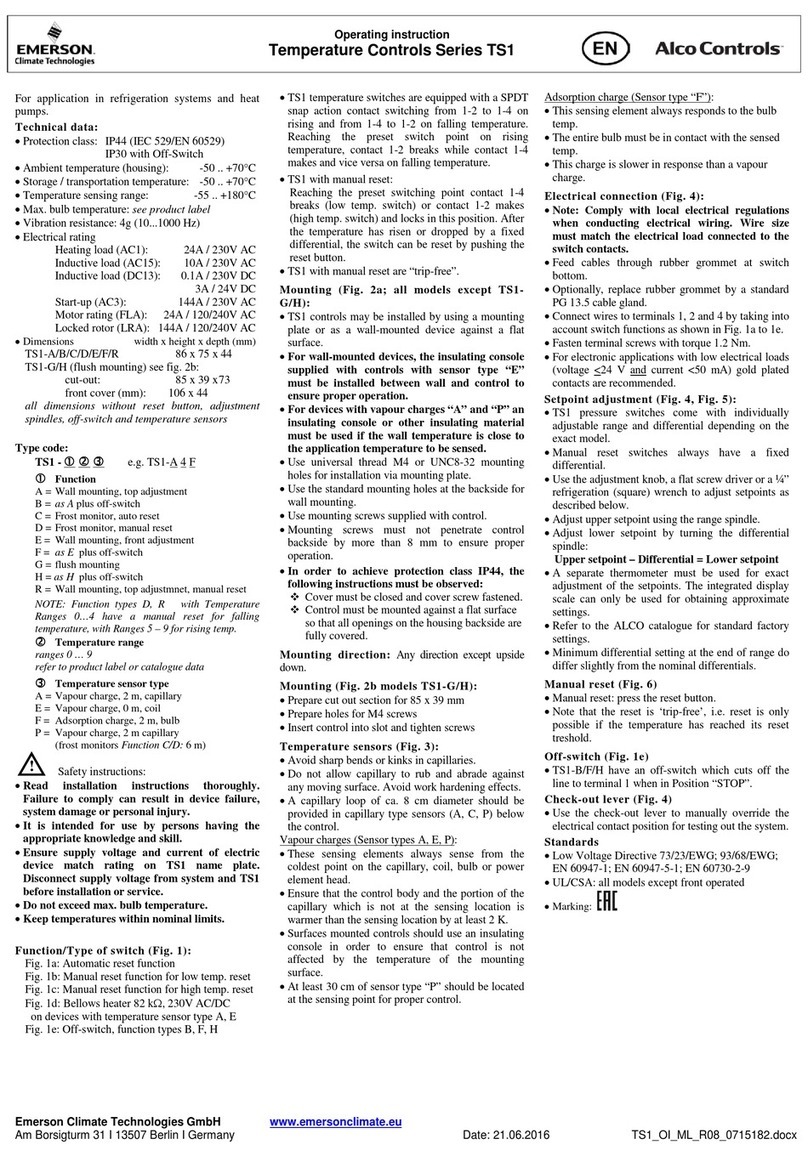
Emerson
Emerson TS1-G Operating instruction
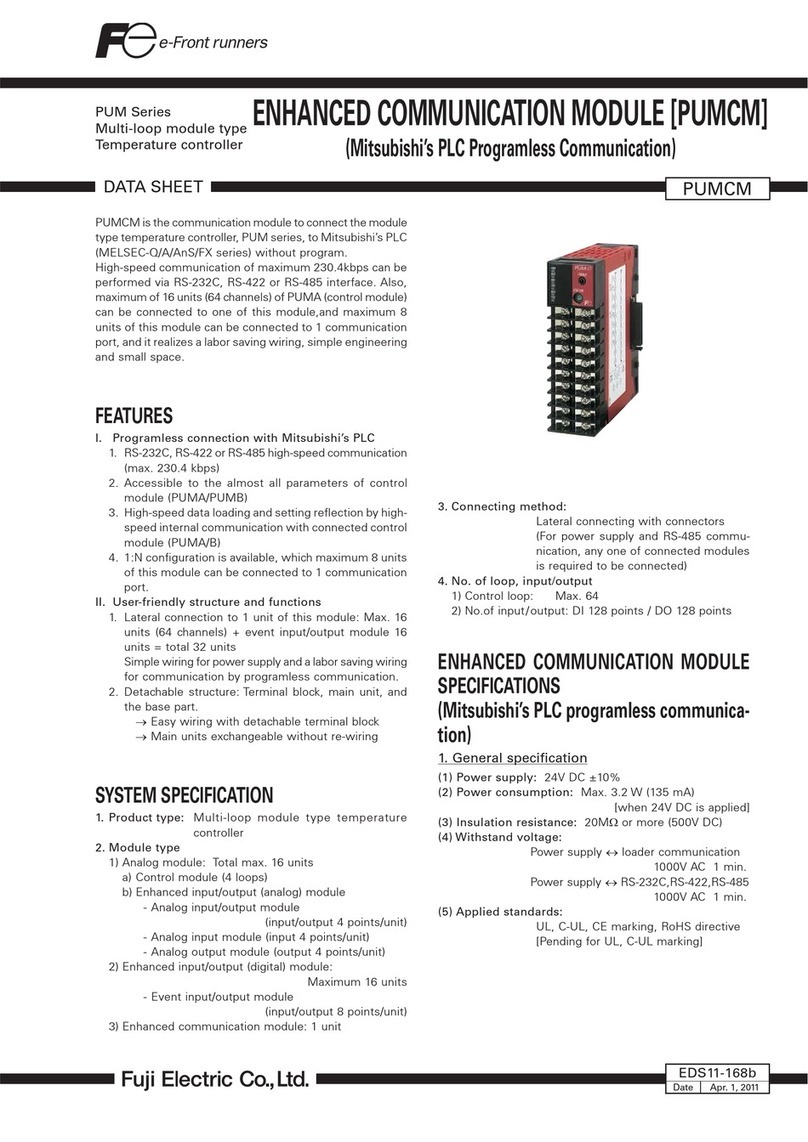
Fuji Electric
Fuji Electric PUM Series Instruction
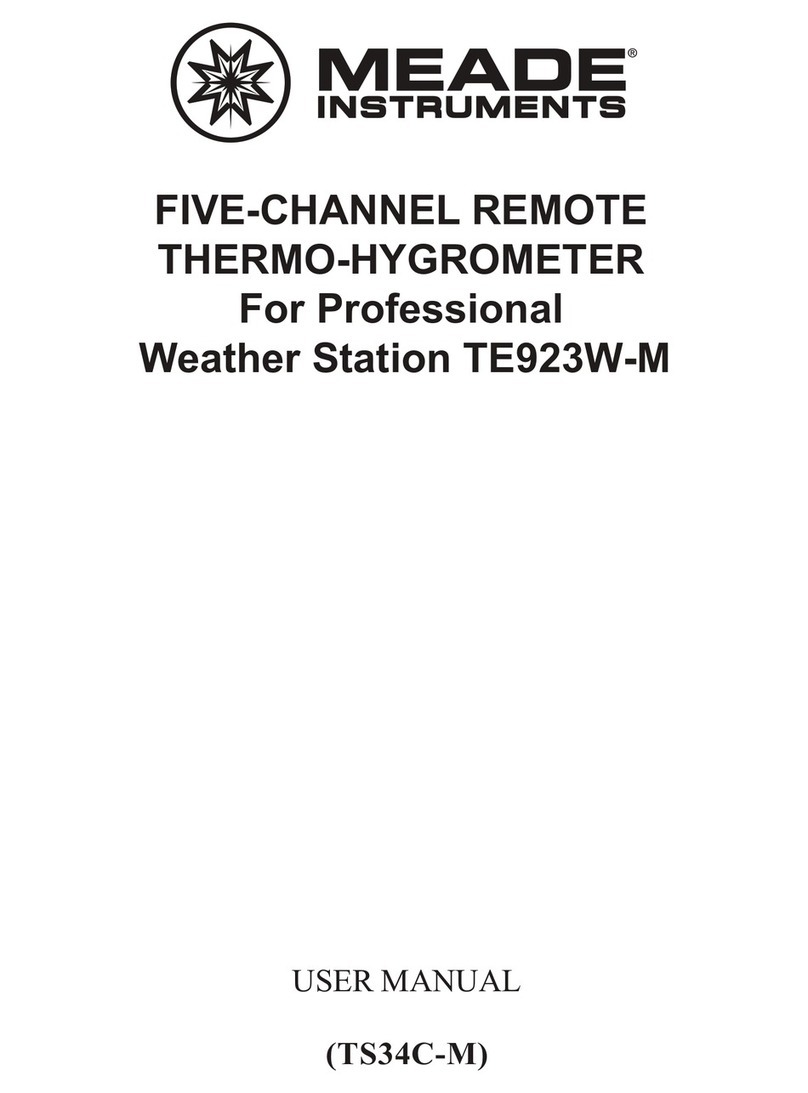
Meade
Meade TS34C-M user manual
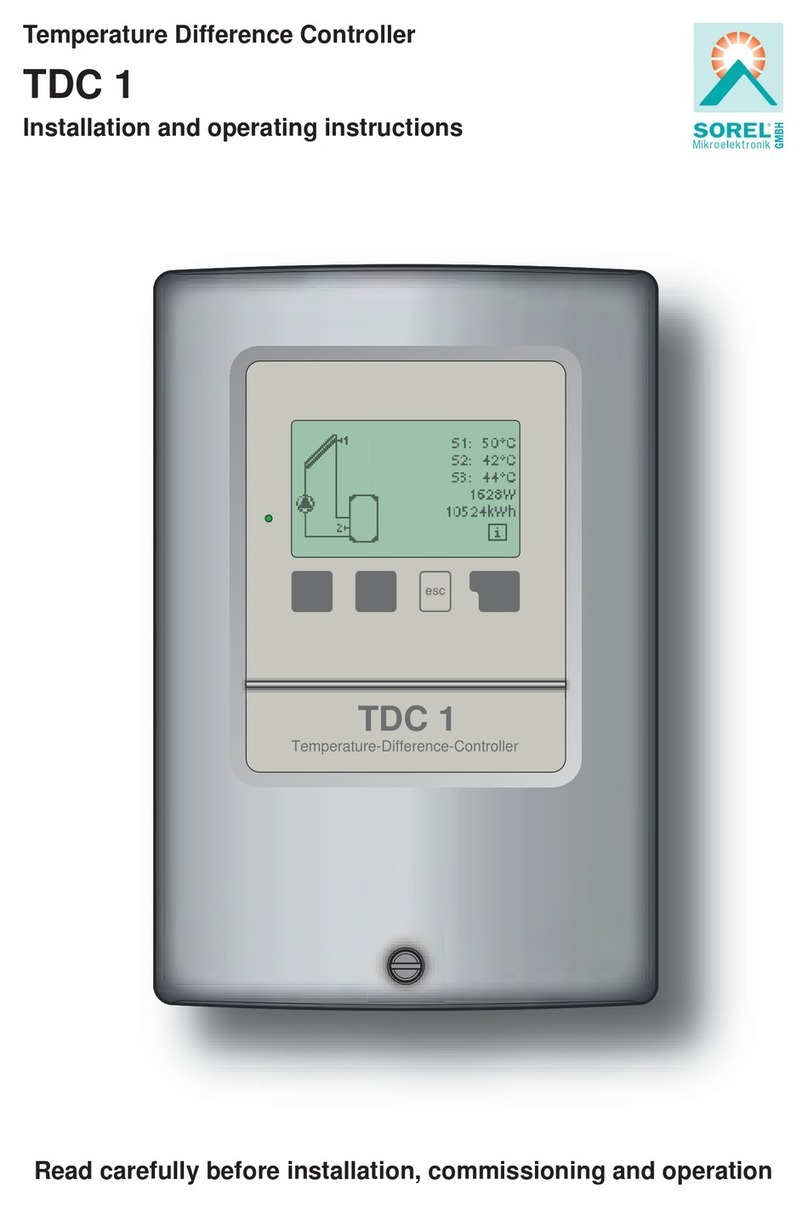
Sorel
Sorel TDC 1 Installation and operating instructions
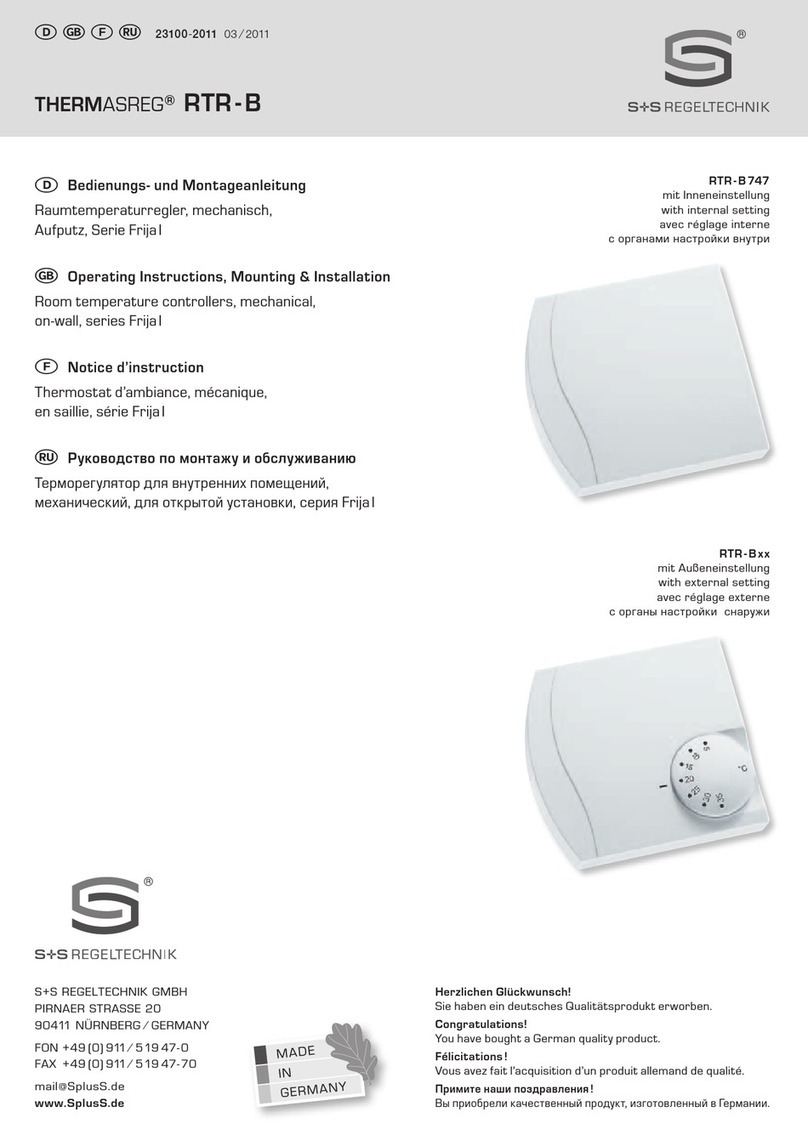
S+S Regeltechnik
S+S Regeltechnik THERMASREG Frija I Series Operating Instructions, Mounting & Installation
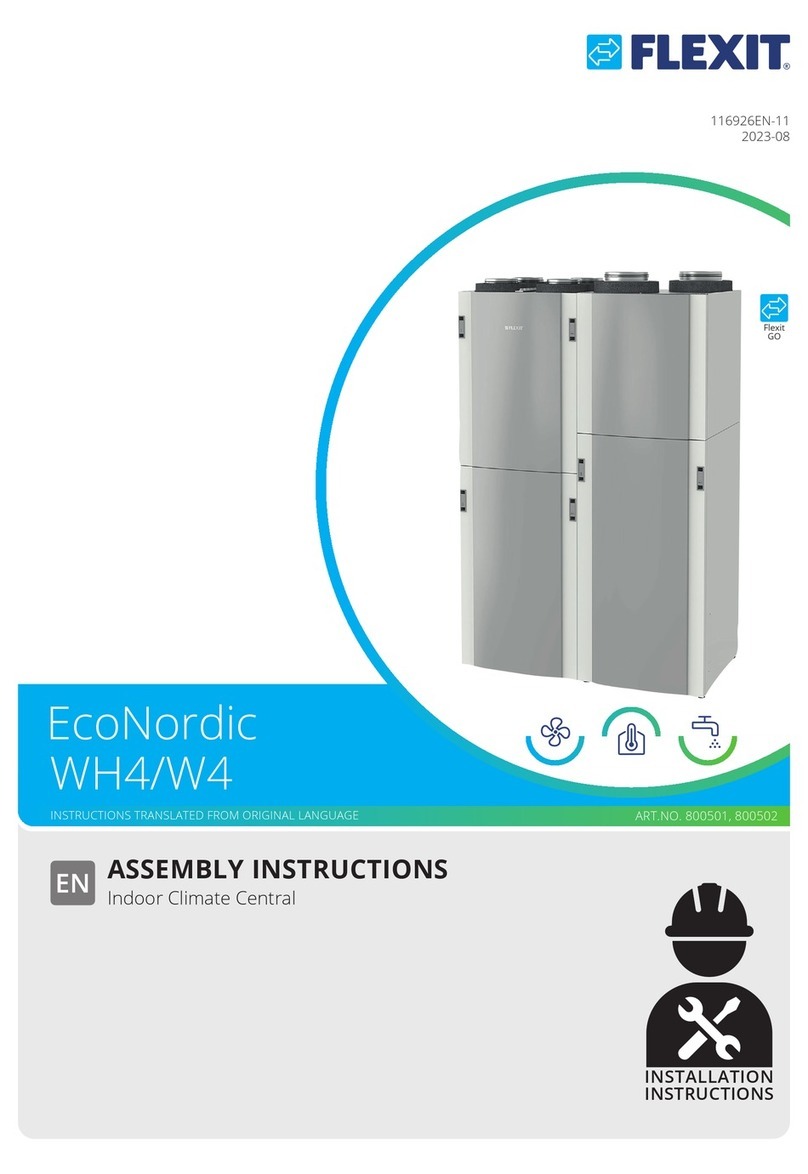
Flexit
Flexit EcoNordic WH4 Assembly instructions
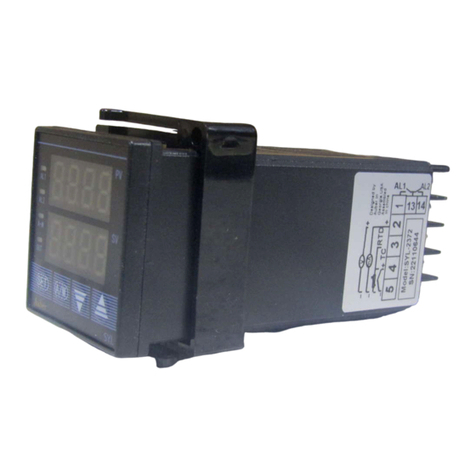
Auber Instruments
Auber Instruments SYL-2372 instruction manual
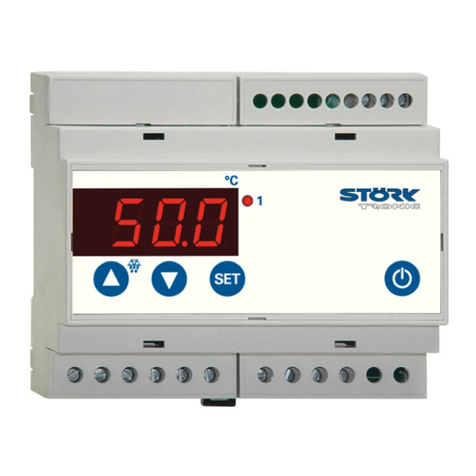
STORK TRONIC
STORK TRONIC ST129-JA1TA.10 manual
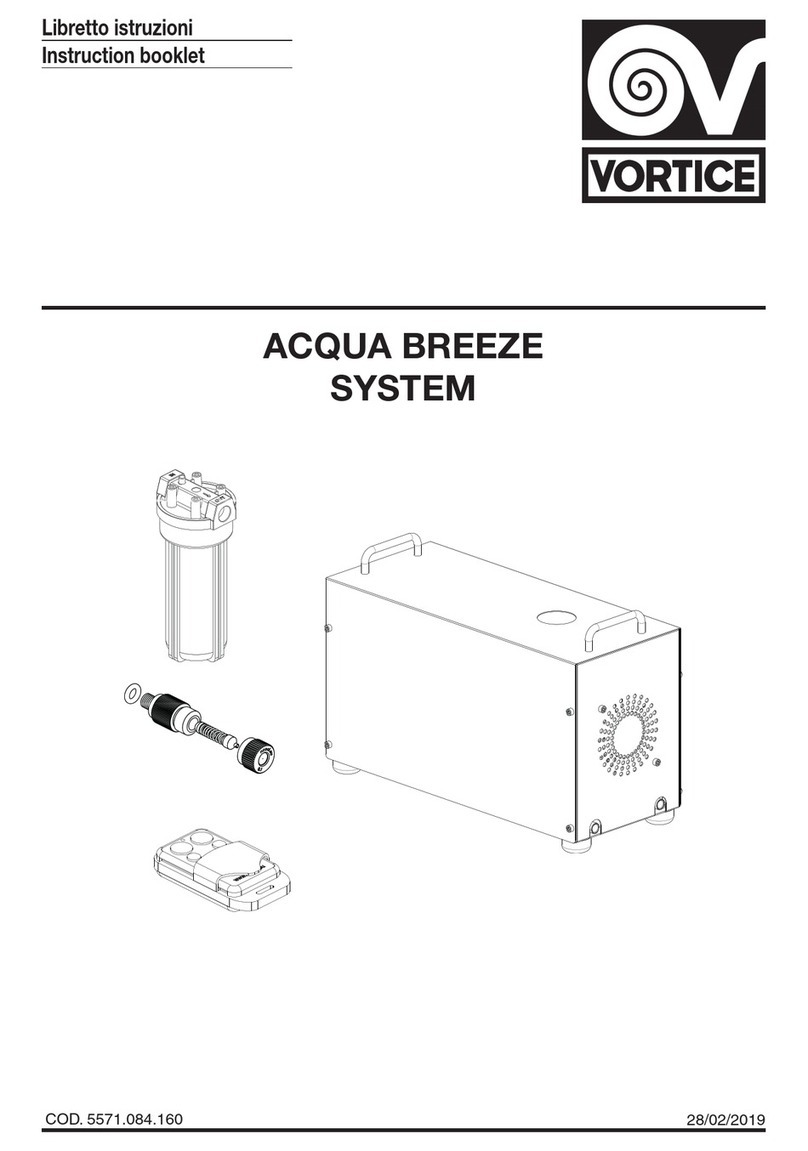
Vortice
Vortice ACQUA BREEZE SYSTEM Instruction booklet
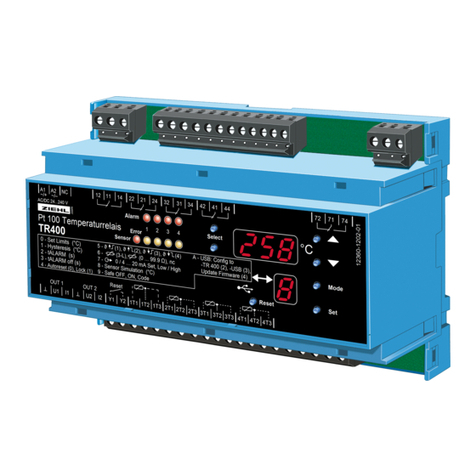
ZIEHL
ZIEHL TR400 operating manual
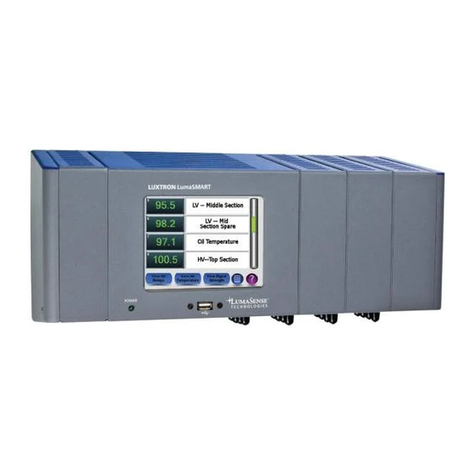
LumaSense technologies
LumaSense technologies LumaSmart quick start guide


